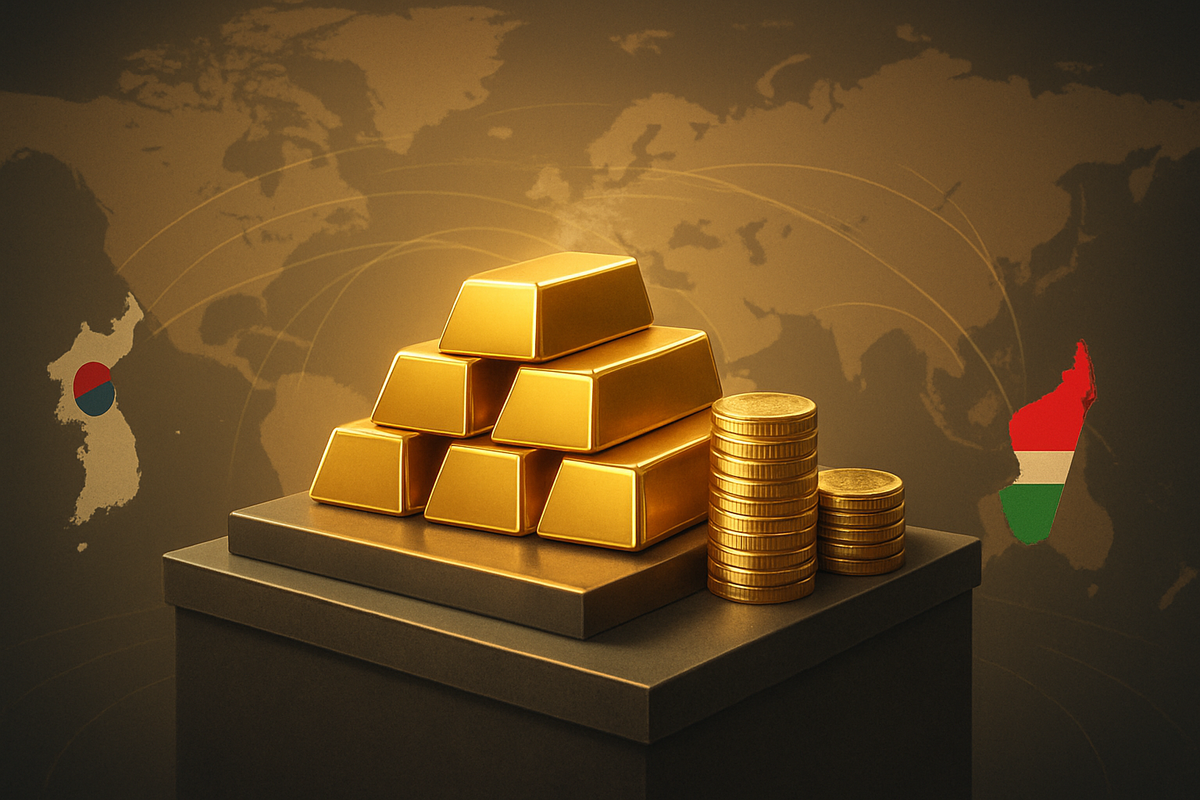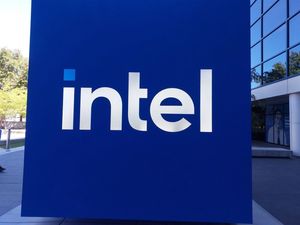
In a significant move reflecting a broader global trend, central banks in both South Korea and Madagascar are either actively pursuing or considering substantial increases to their gold reserves. This strategic pivot signals a growing desire among monetary authorities to diversify national assets, hedge against economic uncertainties, and reduce reliance on traditional reserve currencies like the U.S. dollar. The implications of these actions extend beyond their respective economies, potentially influencing global gold demand, international financial stability, and the ongoing de-dollarization narrative.
The Bank of Korea (BOK) is reportedly contemplating resuming gold purchases for the first time in over a decade, viewing such a move as a "medium- to long-term consideration" for its reserve management strategy. This reconsideration comes amidst persistent domestic inflation and volatility in the Korean won against the U.S. dollar, highlighting gold's historical role as a stabilizing hedge. Meanwhile, the Central Bank of Madagascar (BCM) has explicitly announced plans to acquire 4 tonnes of gold, having already secured 1 tonne of refined gold in July 2023. This initiative is a direct response to declining foreign exchange reserves and a strategic effort to bolster financial resilience in an economy vulnerable to climate risks and commodity price fluctuations.
Strategic Shifts and Historical Context
The Bank of Korea's current gold reserves stand at 104.4 metric tons, a figure unchanged since its last acquisition in 2013. This previous buying spree, which saw the BOK purchase 90 tons between 2011 and 2013, was followed by a global gold price slump, leading to domestic criticism and a cautious approach for years. Key players in this current reconsideration include Heung-Soon Jung, head of the BOK's Reserve Investment Division, who has publicly acknowledged gold's role as an inflation hedge and an alternative investment. The BOK's renewed interest is largely driven by a desire to stabilize the Korean won and align with a global trend of central bank gold accumulation. Initial market reactions to Korea's potential re-entry are cautious, with observers monitoring the timing and scale of any future purchases.
In contrast, the Central Bank of Madagascar has already embarked on its gold accumulation journey. Under the leadership of Governor Aivo Andrianarivelo, the BCM received 1 ton of refined gold in July 2023, with a clear objective to reach 4 tonnes. This move is critical for Madagascar, whose foreign-exchange reserves had dwindled, partly due to a decline in vanilla exports. The BCM's strategy aims to strengthen its financial buffers against external shocks. However, Madagascar's approach has faced scrutiny, with the International Monetary Fund (IMF) raising "safeguard concerns" in April 2021 regarding the BCM's purchases of unrefined gold from local producers. The recent acquisition of refined gold suggests an effort to address these past concerns and ensure transparency in its sourcing methods.
Market Winners and Potential Losers
The increased demand for gold from central banks in Korea and Madagascar, as part of a wider global trend, is poised to significantly impact various public companies, primarily through its influence on global gold prices.
Gold Mining Companies stand to be direct beneficiaries. Higher gold prices translate into increased profitability, revenues, and cash flows for miners. This can incentivize greater investment in exploration and production. Major global players like Newmont Corporation (NYSE: NEM), Barrick Gold (NYSE: GOLD, TSX: ABX), Agnico Eagle Mines (NYSE: AEM, TSX: AEM), and Kinross Gold (NYSE: KGC, TSX: K) are likely to see their valuations improve.
Gold Exchange-Traded Funds (ETFs) will also benefit. As central bank demand supports gold prices and boosts investor confidence, increased inflows into gold ETFs, such as SPDR Gold Shares (NYSE Arca: GLD) and SPDR Gold MiniShares (NYSE Arca: GLDM), are expected, leading to higher assets under management and share prices.
Beyond direct gold exposure, gold refiners and dealers will likely experience increased business volumes. Commodity trading firms and banks with precious metals desks, such as JPMorgan Chase (NYSE: JPM) and HSBC Holdings (LSE: HSBA), will also benefit from heightened market activity. Indirectly, if gold purchases contribute to greater economic and currency stability in South Korea and Madagascar, it could generally benefit domestic banks and financial institutions within those countries.
Conversely, potential negative impacts are more indirect. Jewelry retailers could face dampened consumer demand if gold prices rise too sharply. While gold acts as an inflation hedge, if the underlying concerns driving central bank purchases (e.g., severe inflation or currency devaluation) were to materialize into extreme economic instability, some inflation-sensitive companies in Korea or Madagascar could face headwinds. Furthermore, companies with poorly managed gold hedging strategies might incur losses due to unexpected price movements. The IMF's past concerns about Madagascar's sourcing of unrefined gold also highlight potential risks for formal local gold producers if transparency and regulatory standards are not met.
Wider Significance in a Multipolar World
The actions of the central banks in Korea and Madagascar are microcosms of a profound global realignment in financial strategy. This event fits squarely into two broader industry trends: de-dollarization and reserve diversification. Many central banks, particularly in emerging markets, are actively reducing their reliance on the U.S. dollar, a trend accelerated by geopolitical tensions, sanction risks, and a desire for greater monetary sovereignty. Gold, immune to such risks, offers an attractive alternative. Simultaneously, central banks are diversifying their reserves to hedge against inflation, currency volatility, and global instability, viewing gold as a stable store of value.
The ripple effects of this sustained central bank gold accumulation are significant. It creates a robust market, potentially prompting other central banks and financial institutions to re-evaluate their own reserve compositions, leading to a "domino effect" of increased gold purchases. For nations like Madagascar, increasing gold reserves can signal financial strength and independence, potentially enhancing their geopolitical standing. Regulatory implications are also at play; the ongoing reclassification of physical gold as a Tier 1 capital asset for U.S. banks under Basel III by July 2025 further solidifies gold's standing as a reserve asset, incentivizing more central banks to diversify.
Historically, central banks have consistently increased gold holdings during periods of global instability and uncertainty, such as the post-Bretton Woods era and after major financial crises. The current trend echoes these precedents, reflecting a collective concern among central banks regarding the stability of the existing international monetary architecture and a return to gold's enduring role as a universal store of value. This underscores a fundamental reassessment of risk and the future of the global financial system, with gold emerging as a preferred asset for financial sovereignty and resilience in an increasingly multipolar world.
The Road Ahead: Scenarios and Adaptations
The strategic pivot by central banks in Korea and Madagascar towards gold portends several short-term and long-term possibilities for the global financial system and gold market. In the short term, even initial purchases can send a positive signal, boosting investor confidence and contributing to upward price pressure. This immediately enhances reserve diversification for both nations and offers a hedge against currency weakness.
Longer-term, increased gold holdings will strengthen monetary sovereignty, providing greater independence from the monetary policies of major reserve currencies. Gold's role as a trusted reserve asset will enhance financial stability and geopolitical resilience, offering protection against sanctions and asset freezes. As these initial acquisitions prove beneficial, central banks may gradually increase their allocations, especially if global uncertainties persist.
Strategic adaptations will be crucial. Central banks will need to restructure their reserve management, potentially reducing exposure to other asset classes. Logistical challenges related to secure storage and security for physical gold will also require attention. Clear policy communication will be essential to manage market expectations and public perception, particularly for the Bank of Korea, given its past experiences. Continuous research and analysis of global economic indicators and gold market trends will inform future purchasing decisions.
Market opportunities include sustained gold price support, potentially incentivizing increased gold exploration and mining. Gold's reinforced role as a portfolio diversifier will encourage private investors. However, challenges persist: gold's opportunity cost during high-interest periods, potential price volatility, and the limited annual global gold supply, which could tighten physical markets if central bank demand remains high.
Overall, the ongoing increase in central bank gold reserves points towards an accelerated de-dollarization, fostering a more multipolar monetary system. This could lead to new trade settlement mechanisms circumventing traditional financial infrastructure. Sustained institutional buying is expected to contribute to increased gold price stability and value, with some analysts forecasting prices to reach $4,000 per troy ounce by mid-2026. This trend ultimately validates gold's position as the "ultimate reserve asset" in an evolving global financial landscape.
A Golden Horizon: Summary and Investor Outlook
The decisions by the Bank of Korea and the Central Bank of Madagascar to bolster their gold reserves are key indicators of a profound and ongoing transformation in global reserve management. These actions underscore a collective effort by central banks to enhance financial stability, diversify away from traditional reserve assets, and build resilience against geopolitical and economic uncertainties.
Key takeaways include the undeniable trend of diversification and de-dollarization, driven by the desire for financial sovereignty and a hedge against global instability. Gold is increasingly valued as a safe-haven asset, leading to a structural shift in demand that creates a long-term price floor for the precious metal.
Moving forward, the market assessment remains robust for gold. Analysts project continued strength in gold prices, with forecasts ranging from $3,675/oz by Q4 2025 to potentially $4,000/oz by mid-2026, largely due to persistent central bank accumulation and prevailing global uncertainties. Macroeconomic drivers, such as U.S. policy uncertainty, trade tensions, and the potential for a weaker U.S. dollar, will continue to underpin gold's appeal.
The significance and lasting impact of this trend cannot be overstated. It validates gold's enduring role as a fundamental reserve asset, contributing to a more diversified and multipolar global financial system. The long-term, price-insensitive nature of central bank buying provides a stable demand base that can reduce market volatility and support gold prices over extended periods.
For investors in the coming months, the long-term outlook for gold remains positive. Price corrections should be viewed as opportunities for new investors to enter the market or existing investors to rebalance portfolios, rather than a signal for panic selling. Gold continues to serve as an optimal hedge against a unique combination of risks, including stagflation, recession, currency debasement, and geopolitical instability. Investors should consider gold ETFs and gold mutual funds for convenient exposure. Crucially, close monitoring of central bank policies, particularly the Federal Reserve's interest rate decisions, U.S. dollar strength, and evolving geopolitical developments, will be essential for navigating the gold market.
This content is intended for informational purposes only and is not financial advice






